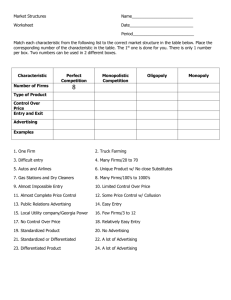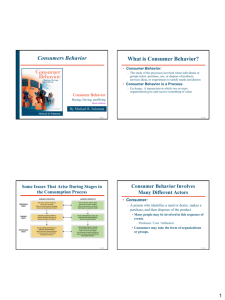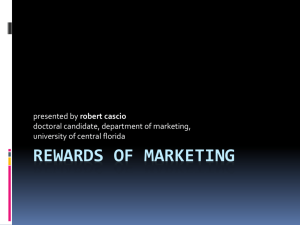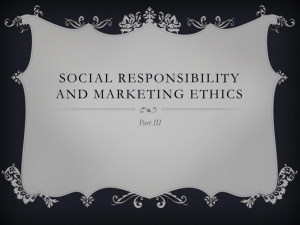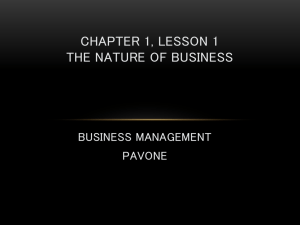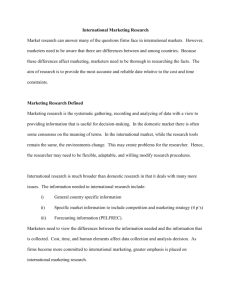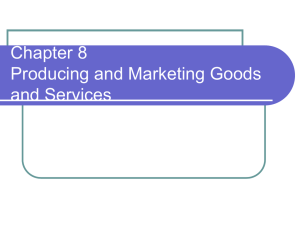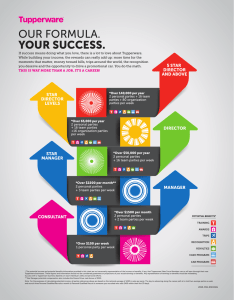PPT
advertisement
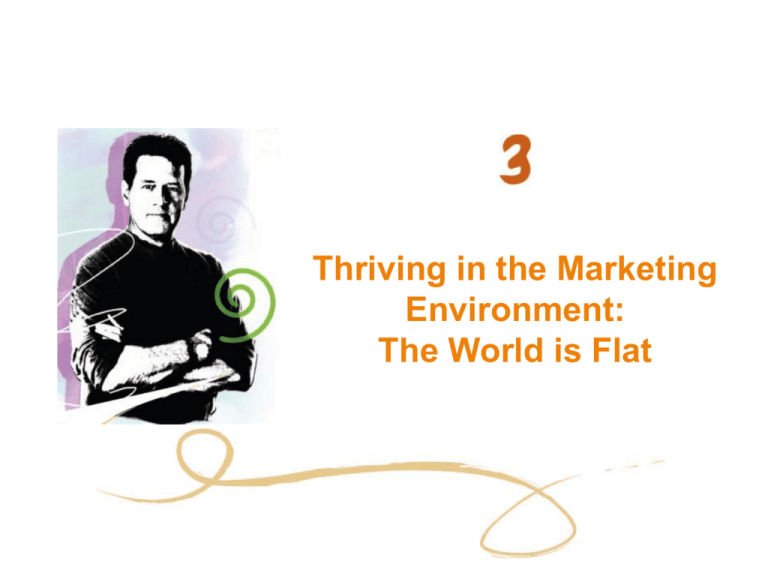
Thriving in the Marketing Environment: The World is Flat Chapter Objectives • Understand business ethics and explain how marketers practice ethical business behavior • Explain how firms practice social responsibility • Understand the big picture of international marketing, including world trade flows and the decision criteria firms use in their decisions to go global • Explain the WTO, economic communities, and how countries protect local industries by establishing roadblocks to foreign companies • Understand how factors in the external business environment influence marketing strategies and outcomes • Explain the strategies that a firm can use to enter global markets • Understand the arguments for standardization versus localization of marketing strategies in global markets 2 Real People, Real Choices: Decision Time at Tupperware • Tupperware Brands Corporation (Rick Goings) • How to refresh brand perception? Option 1: increase advertising in new markets Option 2: utilize public relations Option 3: build demand using word-of-mouth TUPPERWARE.COM 3 Welcome to the New Era of Marketing • Adopt a global focus • Managers emphasis social profit: net benefit for a firm and society from the firm’s ethical practices and socially responsible behavior INTERFACEINC.COM 4 Figure 3.1: Linking Ethics to Profits 5 Doing Good: Ethical Behavior in the Marketplace • Business ethics: basic values that guide a firm’s behavior • Codes of ethics: written standards of behavior to which everyone in the organization must subscribe 6 Consumerism: People Fighting Back • The social movement directed toward protecting consumers from harmful business practices • Consumer Bill of Rights: the right to be safe, be informed, be heard, and choose freely PHILLIP MORRIS 7 Discussion • In 2006, the National Institutes of Health released the results of a study showing that young people tend to drink more in areas with more alcohol advertising compared to areas with less advertising Do alcohol companies have an ethical obligation to curtail their advertising in order to decrease drinking rates among young people? 8 Ethics in the Marketing Mix • • • • Making the product safe Pricing the product fairly Promoting the product ethically Making the product available ethically 9 Discussion • Some people criticize advertising as being deceptive Do you agree or disagree? What would be the advantages and disadvantages to firms when they deceive consumers? 10 Doing It Right: Promoting Social Responsibility • Social responsibility: organizations engaging in activities that have a positive effect on society and promote public good NFL Video CORPORATE RESPONSIBILITY AT INTEL 11 Doing It Right: Promoting Social Responsibility (cont’d) • Serving the Environment • Serving Society: Cause Marketing • Serving the Community: Promoting Cultural Diversity 12 Individual Activity • Write down some thoughts about how products/services have the potential to harm you individually In your opinion, do any products “cross the line” when it comes to your level of comfort? 13 Global Marketing • World Trade: the flow of goods/services among different countries – the value of all exports/imports of the world’s nations • Countertrade: trading products between countries or supplying goods in return for tax breaks from local government (accounts for 25% of all world trade) 14 Figure 3.3: North America Trade Flows (in $billions) 15 Figure 3.4: Decision Model for Entering Foreign Markets 16 Making the Decision to Go Global • “Go” or “no go”: is it in the best interest of the firm to remain in home market or to go where opportunities exist? • Which global markets are most attractive? • Key to the decisions: market conditions and creating a competitive advantage 17 At the Borders • Protectionism: quotas, embargoes, and tariffs • World Trade Organization (WTO): to “help trade flow smoothly, freely, fairly, and predictably” • Economic communities promoting trade 18 Discussion • Do you think the WTO will succeed in eliminating world trade barriers? • What do you think are the positive and negative aspects of a totally free marketplace? • What countries will win and which will lose in such a world? 19 The Global Marketing Environment • A company going global must understand local conditions in the targeted country • Understanding the external environment: economic, competitive, technological, political, and cultural factors affect marketers’ global strategies 20 The Economic Environment: Indicators of Economic Health • Economic health = market potential for firm • Gross domestic product (GDP): total dollar value of goods/services a country produces within its borders in a year • Per capita GDP: total GDP/number of citizens 21 Indicators of Economic Health (cont’d) • Gross national product (GNP): the value of all goods/services produced by a country whether in its borders or not • Economic infrastructure: quality of country’s distribution, financial, and communications systems 22 Level of Economic Development • Less developed country (LDC) Economic base is often agricultural Attractive markets for staples and inexpensive items • Developing countries Economy shifts emphasis from agriculture to industry • Developed countries Offer wide range of opportunities for international marketers 23 The Business Cycle • • • • • Prosperity Recession Recovery Depression Inflation 24 The Competitive Environment • Competitive intelligence: gathering and analyzing publicly available information about rivals to develop superior marketing strategies Collected from news media, the Internet, and publicly available government documents 25 The Competitive Environment (cont’d) • Competition in the microenvironment • Competition for consumer’s discretionary income • Competition among products to satisfy the same consumer’s needs/wants • Competition among brands offering similar goods/services on the basis of brand reputation or perceived benefits 26 The Competitive Environment (cont’d) • Competition in the macroenvironment (overall structure of industry) Monopoly Oligopoly Monopolistic competition Perfect competition 27 The Technological Environment • Technology provides firms with important competitive advantages • Patent: legal document giving inventors exclusive rights to produce/sell a particular invention in that country 28 The Political and Legal Environment • Local, state, national, and global laws and regulations affect businesses • The law in the United States To make sure businesses compete fairly with each other To make sure that businesses don’t take advantage of consumers 29 The Political and Legal Environment (cont’d) • Political Constraints on Trade Economic sanctions Nationalization Expropriation • Regulatory constraints on trade Local content rules: a proportion of a product must consist of components supplied by industries in the host country or economic community • Human rights issues 30 The Sociocultural Environment • Demographics • Cultural values Collectivist versus individualistic cultures • Norms, customs, mores, and conventions • Language • Ethnocentrism: the tendency to prefer products from one’s own culture 31 Discussion • Some countries have criticized U.S. business for exporting American culture What about American culture might be objectionable? Can you think of some products that U.S. marketers export that can be objectionable to some foreign markets? 32 Group Activity • What global external environment factors would you consider to be critically relevant for the following products (form a small group and pick one of the products listed below): Coffee Cars Video games Sporting events Computers Soda 33 How “Global” Should a Global Marketing Strategy Be? • Market-entry strategy: the level of commitment to operate in another country Figure 3.4 34 How “Global” Should a Global Marketing Strategy Be? (cont’d) • Exporting • Contractual agreements Licensing Franchising • Strategic alliances Joint venture • Direct investment • Born-global firms LOGITECH 35 Global Marketing: Choosing a Marketing Mix Strategy • Standardization vs. localization Standardization: offer the same products in all markets Localization: offer a customized marketing mix for each country 36 Global Marketing: Choosing a Marketing Mix Strategy (cont’d) • Product decisions Straight extension strategy Product adaptation strategy Product invention strategy Backward invention • Promotion decisions: whether or not to modify promotions 37 Global Marketing: Choosing a Marketing Mix Strategy (cont’d) • Price decisions Free trade zones Gray market goods Dumping • Distribution decisions 38 Group Activity • Form a small group and formulate either a brief standardized or local strategy in a foreign country (of your choice) for one of the following products: Tide laundry detergent Verizon cellular phone service Direct TV service Hollister clothing Weber gas barbecue grills 39 Real People, Real Choices • Tupperware Brands Corporation (Rick Goings) • Rick chose option 2: Utilize public relations Since the campaign launched in April 2005, Tupperware has seen a significant increase in the number of media exposures it has gotten 40 Discussion • The World Trade Organization seeks to eventually remove all barriers to world trade. • Do you think this will ever be a reality? • What do you think are the positive and negative aspects of a totally free marketplace? • Which countries will win and which will lose in such a world? 41 Marketing in Action Case: You Make the Call • What is the decision facing New Balance? • What factors are important in understanding this decision situation? • What are the alternatives? • What decision(s) do you recommend? • What are some ways to implement your recommendation? 42 Keeping it Real: Fast Forward to Next Class Decision Time at Plan-it Marketing • Meet Cindy Tungate, president Plan-it Marketing, a marketing research firm • Plan-it’s client Priceline needs help in planning its business • The decision: What marketing research strategy will maximize results for Priceline? 43
